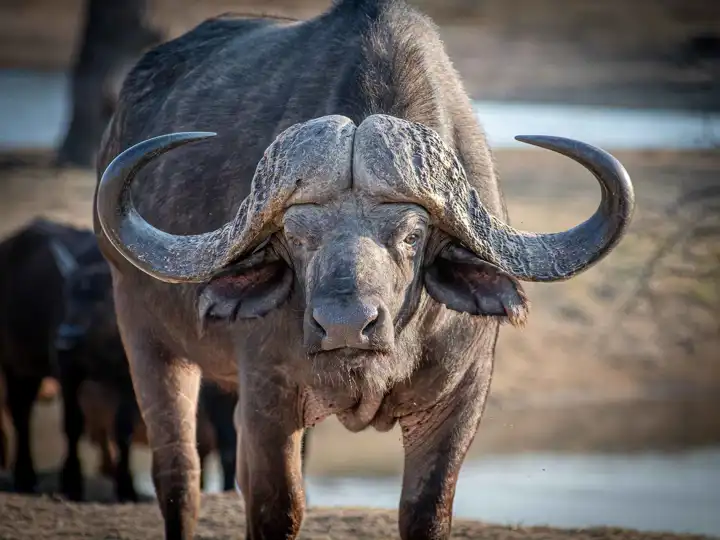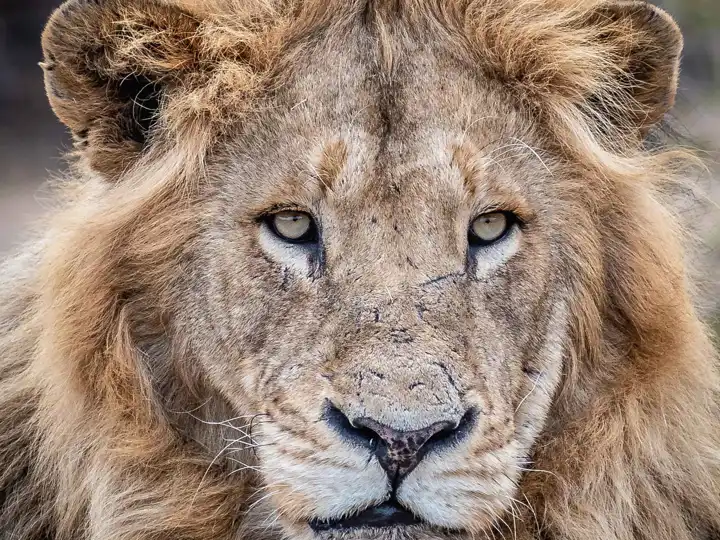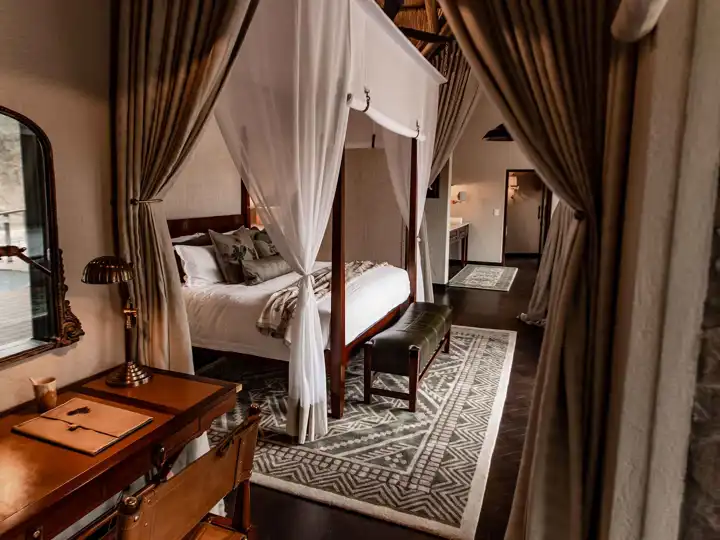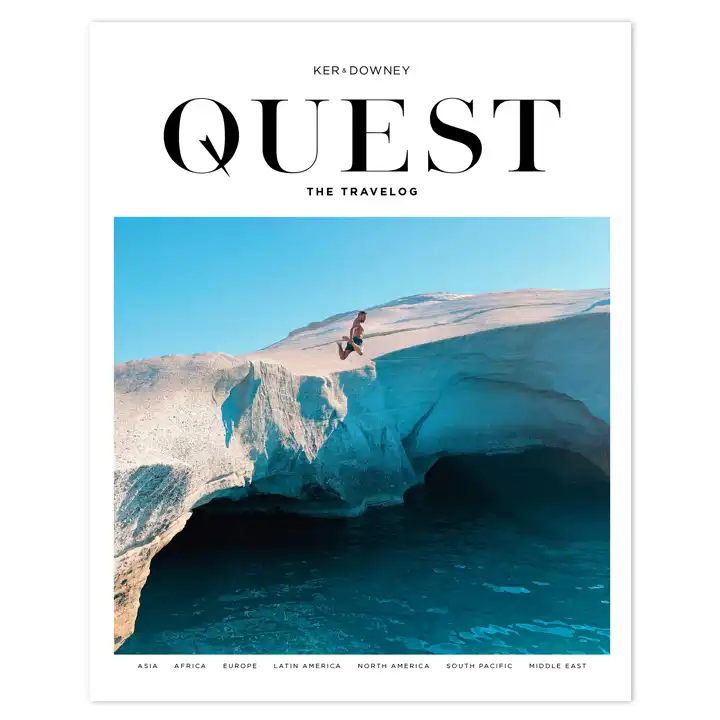Life in the Wild
As Seen in Quest
By Lauren Kramer
The air is thick with humidity and the shrill cry of cicadas the day we arrive at Dulini Moya, a private lodge in South Africa’s Sabi Sand Nature Reserve. Sweat-soaked clothes stick to clammy skin as my daughter and I climb into a Land Rover, excited at the prospect of our first game drive. We haven’t even started the engine before the jungle offers its first clue in our search for wildlife: a clucking sound coming from the trees above us. “That’s a monkey,” says our guide, Riaan, pointing upward at the wizened face of a vervet monkey who is gazing at the dry riverbank. “Chances are there’s a leopard nearby and he’s alerting the troop.”
The monkeys’ warning sounds follow us as we exit the lodge gate, and within seconds we see her: a young female leopard walking slowly towards us and into the bush. We follow her in the vehicle, so close we can see the texture of her tongue as she laps water from a small waterhole. Completely undisturbed by our presence, she stops for a rest before venturing on, searching for a scrub hare that will be her next snack.
The Sabi Sand
The Sabi Sand is a 60,000-hectare private game reserve created in 1945, when 14 neighboring landowners moved their cattle elsewhere, eliminated hunting, and reintroduced wildlife to the area. Over the years, as new owners took the helm, they built luxury boutique lodges where guests could experience private, exclusive wildlife safaris.
The reserve shares an unfenced border with the famous Kruger National Park next door, and while wildlife moves freely between the two parks, the same isn’t true for human visitors. Millions of guests visit Kruger each year, and when animals are sighted the roads in that park are often congested. By contrast, some of the boutique lodges in the Sabi Sand accommodate just six to eight guests at a time, which means the gravel roads are ours and ours alone as we search for game. Our guides also have the freedom to venture off-road to deliver close-up animal encounters—the kind you’d never get on a self-driven safari.
A storm is brewing, and distant thunder rolls across the sky as we drive on. We pass a herd of female elephants with their young, stopping to watch them feed and gently guide their babies. Again, we are so close to these massive creatures that we could easily reach out and touch them. But this is the African wilderness, and we’re under strict instructions to stay seated and still in the vehicle. The elephants, completely aware of our presence, are unperturbed.

“It’s the buffalo I’m more worried about,” Riaan admits as we drive on, passing a couple of buffalo who stop feeding and peer at us sternly beneath their stately horns. “What will we do if they charge us?” one of the guests worries out loud. Our guide is calm but alert as he scans the lowveld savannah. “Most animals want to avoid a confrontation—but male buffalo can be unpredictable, grumpy, and aggressive. Once they commit to a charge, nothing will stop them short of a bullet, and it would have to be right between the eyes.”
Riaan carries a rifle just in case, but in ten years of guiding, he’s never once had to use it. As dusk descends, we stop for drinks on the banks of a dam, sipping liqueur on ice as we watch the backs of several large hippos emerge from the muddy water. When a hyena approaches the water’s edge for a drink they object loudly, voicing their displeasure with loud, guttural grunts and parting their jaws to reveal cavernous pink mouths. “They pose no danger unless we block their path,” Riaan says. “But avoid the water’s edge, because a very large crocodile lives here.”
We drive back to the lodge for dinner as lightning illuminates the sky, pausing only to admire the towering legs of a female giraffe. As she gazes from long lashes in a single direction, Riaan murmurs that she may have seen a predator nearby. The next day we learn he was spot on: Her newborn giraffe calf had been dragged into the bush by a pack of hyenas, and was steadily being ripped apart, limb by limb.
Darwin’s “survival of the fittest” theory is laid bare on an African safari, where only the fittest and fastest survive. Over the next three days we see a buffalo with a bleeding, lacerated tail and a lion with an open wound—telltale signs of violent encounters with other predators. We touch the skull of a buffalo taken by lions a few months earlier, its remnants licked clean by hyenas and vultures. And we see the limp body of a young impala killed by a leopard, its body dragged high into the branches of a tree where the leopard will return to finish its meal. There is logic, necessity, and a brutal beauty to the cycle of life here, and the ability to glimpse it in process is spellbinding.

We settle easily into the magical rhythm of a safari: 5am wakeups to tea at the lodge, the vervet monkeys scampering in the treetops above us, waiting for a chance to snatch muffins from the breakfast basket. The game drives leave at 6am, just as the jungle begins to stir. It’s a time when the air is filled with bird song and the flash of their iridescent color, and the heat has not yet lulled the animals into a state of lethargy. The day’s second game drive begins in the late afternoon, as the animals begin to stir, roused from the heat of the day and ready to pursue their next meal.
Riaan and our tracker keep a careful eye on the ground, noting the direction and size of animal tracks, the clues in the daily detective journey of finding the animals. The tracks tell us a herd of buffalo passed through the night before and that the lions were circling them. We start looking for the pride, but long before we find them, there are so many reasons to stop, listen, and watch.
We spot two giraffes munching on the thorny branches of acacia trees and learn how the acacia trees raise their tannin levels if they’re being over-eaten, to encourage the giraffes to move on. We watch the red-billed oxpecker birds that hop along the giraffes’ backs, necks, and underbellies, eating ticks and dead skin. And we see the African dung beetle toil, pushing a perfect sphere of elephant dung along the path as it prepares to lay its eggs inside the warm matter.
When we find the lion pride, most of the big cats are fast asleep, their bellies bloated from an overnight feast. We gaze mesmerized at the strength in the cats’ massive paws and its stark contrast with their sleepy postures. A young male walks past us, so close we can hear its panting breath and see the blood stain on its chin from the kill just hours before. Another lion chews on the last remnants of the kill, licking the meat off the bone as a hyena hovers nearby, waiting for its turn at the carcass.
One afternoon we follow rhinoceros tracks until we run straight into the shy male rhino. He watches us carefully from the bushes, giving us only the briefest glimpse of his hornless face. The rhinos are darted from helicopters every 18 months, and their horns are removed in a methodical strategy to save them from the greed of poachers. “The horn removal also helps when two rhinos get into a fight,” Riaan explains. “Without horns they don’t inflict as much damage on each other.”

Back at the lodge we spend leisurely afternoons in our private plunge pool, watching elephants and kudu as they move along the dry riverbank before us. We dine on sumptuous food, converse with other guests over drinks on the sprawling leather couches, and scroll through our cameras to feast on the day’s photographic highlights. At candlelit dinners we enjoy a sophisticated, wine-paired meal, listening as visiting winemakers from the Cape discuss their viticulture. And at bedtime we are escorted to our chalets by staff – just in case we encounter an animal on the path – and slip into four-poster beds decked in fine linens.
Game drives in the African bush demand patience and offer no guarantees of wildlife sightings. Some drives are long and yield few sightings, while others are a frenzy of activity, animals appearing around every corner. On our last day we head offroad, our Land Rover lumbering through the bush over boulders and fallen trees, until we reach the tree where a leopard cub rests high up in a branch. We watch as he looks around in search of his mother, who has likely disappeared for as long as a day or two as she hunts. “When she’s made her kill, she’ll drag it into a tree and then come back for the cub,” Riaan explains. “Until then, that cub will wait in those branches, where it’s safe from the lions.”
We pull over on the banks of a dam for tea, admiring the work of weaver birds as they reinforce the nests they suspend from tree branches. A pod of hippos is grunting, just their backs visible above the water, and around us the jungle is thrumming with activity, as animals feed, build, hunt, rest, and care for their young.
Riaan gestures to the other side of the dam where a group of impalas is prancing, graceful, light and delicate as ballerinas. “Can you think of a better place to be?” he asks. Truth is, we can’t. At Dulini Moya we’ve been whisked away on a timeless journey, watching in stunned silence at the grace and beauty with which life unfolds in the wild. Elephant bulls in their sexual prime competing for the attention of the females in a herd. Lions, fighting for territory and dominance, often until the death. Kudu and impala feeding in grassy meadows, always alert to the possibility of danger.
It’s a breathtaking, life-changing experience to see this up close, and we leave feeling grateful that whatever the state of our chaotic world, this rugged landscape and the animals and birds that live here remain protected.
Pro Tip: "During your stay, be sure to make time for a visit to some of Dulini's community projects. The incredible esiDulini Community Trust supports a nursing home, a digital learning campus, and Project Dignity, which provides washable sanitary towels to young girls to ensure they can remain in school." - Vanessa, Africa Product Manager
*Main Image via Dulini Moya

Quest Magazine
Dedicated to the experiential style of Ker & Downey travel, QUEST Magazine features eye-opening content that focuses on unforgettable experience, unheard-of destinations, and the very best our world has to offer. Each issue is packed with insider information, what's new in the world of travel, and editorial pieces that focus on our global culture, philanthropy, and transformative travel.
Read Issue 21
Talk to A Travel Designer
Get advice and suggestions to make this your perfect trip.
Or give us a call at 800.423.4236.
Inquire NowSee What We Are Up To
Subscribe to our Weekly Newsletter for Travel Tips and Insider Guides for Planning your Next Journey!
